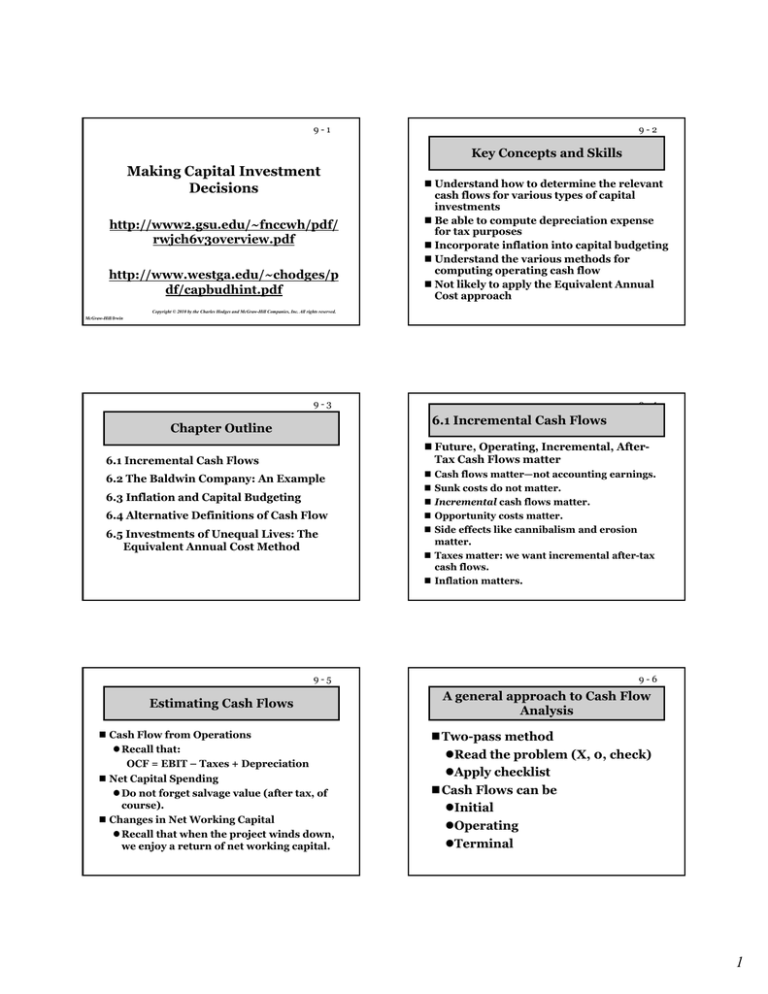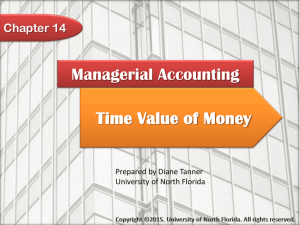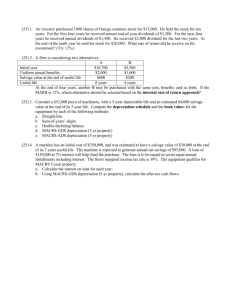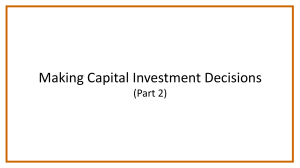
9-1
9-2
Key Concepts and Skills
Making Capital Investment
Decisions
http://www2.gsu.edu/~fnccwh/pdf/
htt
//
d / f
h/ df/
rwjch6v3overview.pdf
http://www.westga.edu/~chodges/p
df/capbudhint.pdf
Understand how to determine the relevant
cash flows for various types of capital
investments
Be able to compute depreciation expense
for tax purposes
Incorporate inflation into capital budgeting
Understand the various methods for
computing operating cash flow
Not likely to apply the Equivalent Annual
Cost approach
Copyright © 2010 by the Charles Hodges and McGraw-Hill Companies, Inc. All rights reserved.
McGraw-Hill/Irwin
9-3
9-4
6.1 Incremental Cash Flows
Chapter Outline
Future, Operating, Incremental, AfterTax Cash Flows matter
6.1 Incremental Cash Flows
6.2 The Baldwin Company: An Example
6 3 Inflation and Capital Budgeting
6.3
6.4 Alternative Definitions of Cash Flow
6.5 Investments of Unequal Lives: The
Equivalent Annual Cost Method
9-5
Estimating Cash Flows
Cash Flow from Operations
z Recall that:
OCF = EBIT – Taxes + Depreciation
Net Capital Spending
z Do not forget salvage value (after tax, of
course).
Changes in Net Working Capital
z Recall that when the project winds down,
we enjoy a return of net working capital.
Cash flows matter—not accounting earnings.
Sunk costs do not matter.
Incremental cash flows matter.
Opportunity costs matter.
Side effects like cannibalism and erosion
matter.
Taxes matter: we want incremental after-tax
cash flows.
Inflation matters.
9-6
A general approach to Cash Flow
Analysis
Two-pass method
zRead the problem (X, 0, check)
zApply checklist
Cash Flows can be
zInitial
zOperating
zTerminal
1
9-7
Operating Cash Flows
Initial Cash Flows
1. Cost of new equipment including shipping and
installation (this is the number that will be depreciated
(depreciable basis)), always a cash outflow (-).
2. Change in working capital (increases in assets are a
use (-) of cash, increases in liabilities are a source (+)
of cash).
3. Tax impact of new equipment (usually not tested).
Replacement only, 4. Salvage Value of Old Equipment,
always a cash inflow (+).
Replacement only, 5 Tax impact of Old Equipment (=
((Book Value – Salvage Value)*tax rate)), may be
inflow or outflow.
9-9
Terminal Cash Flows
Bottom-Up Approach
z Works only when there is no interest
expense
z OCF = NI + depreciation
Top-Down Approach
z OCF = Sales – Costs – Taxes
z Do not subtract non-cash deductions
Tax Shield Approach
z OCF = (Sales – Costs)(1 – T) +
Depreciation*T
A modified income statement for each year of the Project
z Look at Changes only
z There can be changes to the balance sheet (e.g. change in
working capital) are listed separate from the operating
cash flows
+ Sales
- Variable Operating Expenses
- Fixed Operating Expenses
- Depreciation (depreciable basis * depreciation percentage)
= EBIT
- Taxes
= NOPAT
+ Depreciation
= Operating Cash Flows
9 - 10
Inflation and Capital Budgeting
1. Salvage Value of the now old New Equipment, always a cash inflow.
2. Tax impact of Old Equipment = ((Book Value – Salvage Value) * tax rate).
Note, book value = purchase price – accumulated depreciation. If you sell
machine for more than book value, this is a profit that creates a tax liability or a
cash outflow (-). If you sell the machine for less than book value, this is a
loss/reduction in profits that creates a tax credit or a cash inflow (+).
3. Recoveryy of Working
g Capital
p
((the exact same number as line 2 in Initial Cash
3
Flows with the opposite sign).
Replacement Problems Only, 4. Opportunity Cost of not receiving Salvage
Value for Old equipment, which is always a cash outflow (-). This is because if
you sell the old machine at time 0 (a cash inflow) you cannot later sell it at the
end of the project. Thus we record the selling price we do not receive as a
negative number.
Replacement Problems Only, 5. Opportunity Cost of tax impact of not receiving
Salvage Value for Old Equipment = - ((Book Value-Opportunity Salvage )*tax
rate). Note the negative sign prior to book value, since line 4 is always a cash
outflow, we reverse the sign for the tax impact.
6.4 Other Methods for
Computing OCF
9-8
9 - 11
For low rates of inflation, this is often
approximated:
Real Rate ≅ Nominal Rate – Inflation Rate
While the nominal rate in the U.S. has
fluctuated with inflation, the real rate has
generally exhibited far less variance than the
nominal rate.
In capital budgeting, one must compare real
cash flows discounted at real rates or
nominal cash flows discounted at nominal
rates.
9 - 12
6.5 Investments of Unequal Lives
If our investment choices have
different life spans, there are
times when application of the NPV
rule
l can llead
d to the
h wrong
decision.
Be careful, this may be a time to
apply Real Options analysis, it
may be a time to modify based on
unequal lives
2
9 - 13
9 - 14
Equivalent Annual Cost (EAC)
Contact Information
The EAC is the value of the level
payment annuity that has the same PV
as our original set of cash flows.
Office: RCOB 18, U. of West Georgia
Office Phone and Voicemail: (770)3018648 (cell) or (678)839-4816 (office)
Class Webpage: Ulearn
E-mail: Ulearn (preferred) or
chodges@westga.edu or
chodges@gsu.edu
Social Networking: Facebook, LinkedIn,
and Instant Messenger
mba8622@hotmail.com
3





